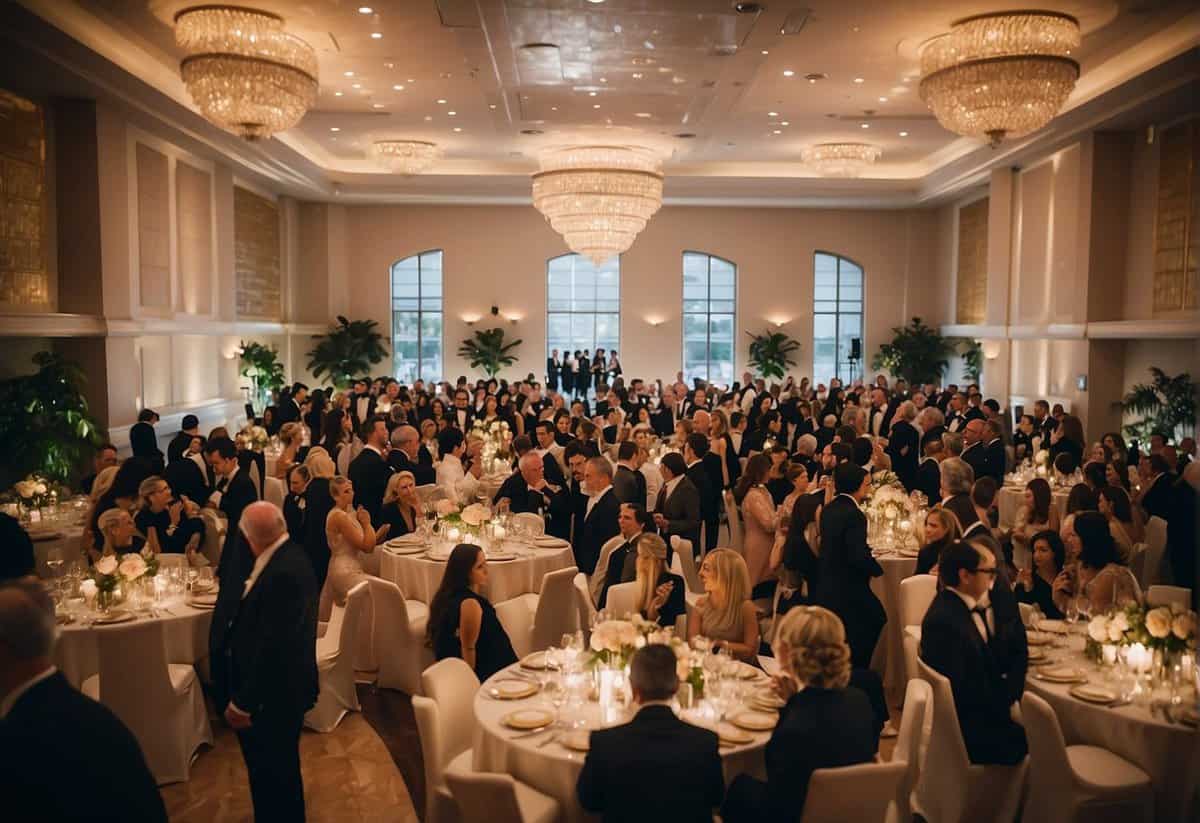Who Gets More Wedding Guests? Factors Influencing Your Guest Count
When it comes to the joyous celebration of a wedding, one of the biggest questions you may face is who gets to bring more guests. It’s a delicate balance—ensuring that both sides of the upcoming union are equally represented in the congregation of family and friends. Planning your big day involves close consideration of guest list size and the harmony it brings to your event.

Navigating who should attend can be tricky; it involves a mix of wedding invitation etiquette, understanding family dynamics, and the essence of celebration itself. As you prepare for your nuptials, remember that this day is about your happiness and the joining of your closest loved ones to share in the joy.
Key Takeaways
- Create a balanced guest list that honors both partners’ friends and family.
- Understand etiquette to manage plus-ones and special requests.
- Consider family dynamics to maintain harmony and ensure a joyful celebration.
Determining the Guest List Size

When planning your wedding, understanding who to invite is a delicate balance between personal wishes and practical constraints. Your guest list affects nearly every aspect of your wedding, from the budget to the choice of venue.
Venue and Budget Considerations
The size of your guest list is directly influenced by your wedding budget and the venue capacity. Before sending out invitations, check the maximum number of guests your venue can comfortably accommodate. Be mindful that a larger guest list can also lead to higher costs for food, beverages, and rentals. Utilize tools like The Knot Guest List Manager to keep track of your invites and align them with your budget.
Importance of Immediate Family
Your immediate family should be at the top of your guest list. This typically includes parents, siblings, and grandparents. Remember to reserve a specific number of seats for them, especially if you’re having a smaller wedding or are working with a limited space. Immediate family often plays a key role in the proceedings, so their presence is generally non-negotiable.
Balancing Friends and Relatives
Determining the right mix of friends and relatives can be challenging. Start with those you deem as essential in your life, and then assess your remaining venue capacity and budget. You might need to make tough choices but prioritize those who have played a significant role in your journey. For help with guest list etiquette and ensuring no one is overlooked, consider using planning tools such as wedding planning apps to sort and manage your list.
Invitation Etiquette
When crafting your wedding invitations, remember to consider the dynamics of your extended family, the significance of your wedding party, and the logistics of RSVP management. It’s all about balancing respect for tradition with the practicality of your event.

Extended Family and Plus-Ones
Extended Family: Inviting family members often includes first-degree relatives such as parents, siblings, and grandparents. However, when it comes to aunts, uncles, and cousins, consider how close you are to them. Keep in mind that every additional family member can increase your cost and venue size requirements. Invitation etiquette suggests that if the budget or space is tight, it’s acceptable to limit invitations to those with whom you share a close relationship.
Plus-Ones: Plus-one etiquette can be delicate, especially for single guests. Typically, it is courteous to offer a plus-one to guests in serious relationships, married, or engaged. For single guests without a significant other, consider factors like their social circle within the guest list or if they’re traveling a long distance to attend.
Wedding Party and Close Friends
Wedding Party: Your bridesmaids and groomsmen are likely your closest allies and should receive an invitation without question. In these cases, extending a plus-one invitation is a gracious move that acknowledges their significant support and role in your wedding.
Close Friends: Prioritize best friends or those who have been integral to your life or relationship. As they are a critical part of your support network, their presence at the wedding is valuable. Be mindful of whether your friends are single or in relationships when sending invitations and consider acknowledging their partners by name.
Managing RSVPs and Last-Minute Changes
RSVPs: Have a clear RSVP date on your invitations to manage your guest count effectively. If you need a final headcount for your caterer, set your RSVP deadline two to three weeks before the wedding day. Make sure you also have a system for following up with guests who don’t respond by the intended date.
Last-Minute Changes: Adjustments to the guest list can happen. If children were not initially included in the invitation, and you choose to invite them later, or if a guest asks to bring an unexpected plus-one, handle these situations with grace. It’s important to communicate changes clearly and promptly, respecting the feelings of your guests while also setting boundaries consistent with your wedding plans.
Navigating Family Dynamics

When planning your wedding, one of the most important aspects to manage is the family dynamics. Your goal is to honor the wishes of both families involved, understand the unique structures they might have, and navigate through the special requests they may bring to the table.
Negotiating Between Partner’s Families
Finding a balance between your partner’s family and your own can be tricky. Start by making a list of the key members like parents, siblings, and close family from both sides, then discuss with your significant other the number of guests each side expects to invite. Keep communication channels open and transparent to align on a fair compromise that respects both families’ desires while adhering to your wedding size and budget constraints.
Inclusion of Step-Families and Non-Traditional Structures
Your wedding guest list should reflect the reality of your family composition, which may include step-families and non-traditional family structures. It’s important to acknowledge these relationships and treat them with sensitivity. Ensure that no significant other or close family member feels excluded. Plan seating arrangements thoughtfully to avoid discomfort and facilitate a welcoming environment for everyone.
Dealing with Special Requests and Family Compromises
Special requests by family members, such as inviting childhood friends or co-workers, must be handled delicately. Weigh each request against your wedding vision and the intimacy level you wish to maintain. Remember, it’s your day, and while compromise is essential, you’re not obliged to accommodate every wish. Have honest conversations with family and family friends early on to set realistic expectations and reduce misunderstandings.
Navigating family dynamics requires patience and understanding, but by keeping these guidelines in mind, you can craft a guest list that makes both you and your families happy.
Special Sections of the Wedding

Wedding planning comes with its fair share of unique events and moments. As you curate your special day, keep in mind the different sections of your wedding, each with their own guest considerations and style choices.
Pre-Wedding Events
Before the main ceremony, there are special pre-wedding events that you might want to host, like an engagement party or a rehearsal dinner. These gatherings are typically more intimate, allowing you to connect with close friends, family, and crucial attendants. When planning these events, think about the joy each guest will bring and how they might contribute to the festive atmosphere. Remember, your guest count for these events doesn’t have to match your wedding day; it’s okay to have a “B-list” for the main event.
- Engagement Party: Normally held soon after the announcement, it’s a great opportunity for your guests to share in the excitement of your upcoming union.
- Rehearsal Dinner: An intimate affair for your wedding party, close family, and possibly out-of-town guests, usually occurring the night before the wedding.
Ceremony and Reception
The heart of your wedding day is the ceremony and reception. This is where you’ll likely have the highest guest count. As you curate the experience, consider the wedding style you desire, which will affect the ambiance and attire of your wedding guests. The officiant will lead your ceremony, which can range from traditional to personalized. If you’re considering a smaller affair, you might elope, ensuring an intimate experience with minimal guests.
- Ceremony: This is where vows are exchanged. Your ceremony can be traditional, non-traditional, religious, or secular. Guest seating is often arranged in order of closeness to the couple.
- Reception: Post-ceremony, the reception is where everyone celebrates. Guests enjoy food, dancing, and entertainment. Your attendants help manage the event, ensuring a smooth flow from toasts to cake cutting.
Consider a post-wedding brunch if you’d like to extend the celebration and thank guests for attending. It’s a laid-back event and a lovely way to wrap up the festivities.
Frequently Asked Questions

Navigating through your wedding planning, especially when it comes to your guest list, can be full of tough decisions. Let’s address some of the most common questions you might have about wedding guests.
What’s the typical number of attendees for a wedding?
A typical wedding can have anywhere from 75 to 150 guests, but it widely depends on personal preferences, cultural expectations, and budget considerations.
What’s a common rule of thumb for creating a wedding guest list?
A commonly cited rule is to divide the list equally between both partners’ families, but this can be adjusted based on individual family dynamics and the total number of guests you plan to invite.
How many guests should you invite if you’re aiming for a certain number of attendees?
If you’re targeting a specific number of attendees, consider that typically 70%-80% of invited guests will RSVP ‘yes.’ Adjust your invites accordingly to hit your desired number.
What proportion of invited guests usually RSVP ‘yes’ to weddings?
Historically, the proportion of guests who RSVP ‘yes’ sits around 70%-80%, but this can vary greatly depending on location, time of year, and the uniqueness of your wedding.
Can you give me some advice on wedding guest list etiquette involving parents?
When involving your parents in the guest list decision, it’s important to communicate openly about expectations and limitations. Parents often want to invite their friends and acquaintances, so set clear boundaries early on.
What’s considered a large number of guests for a wedding?
A wedding with more than 150 guests is generally considered large, and anything above 200 is often labeled as a ‘very large’ or ‘grand’ wedding. Remember, the size of your guest list should reflect what you truly want for your day.


